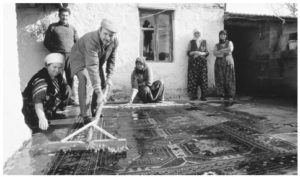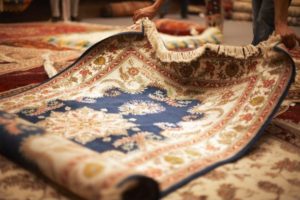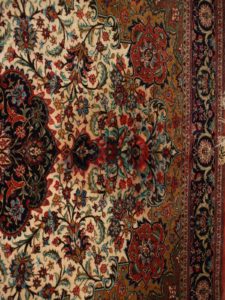Have you ever walked into a lounge room and seen a valuable oil painting on the floor? Why, that would be madness!
Who in their right mind would put a valuable artwork in reach of children, pets and dashed with the ignominy of being walked on? There probably are some artsy types that may like that, so maybe that is a bad analogy.
Nevertheless, back to the main point.
In most well-appointed family homes, located on the floor of the main living room is an Oriental rug. Handcrafted by master artisans, yet seemingly treated with contempt. The kids play on it, the cat teases it’s claws into it, and who knows what the pooch does on it when no one is in sight.
How Often Should I Clean My Oriental Rug?
To see if it is time to clean your rug, try this small test.
The Sniff Test
Get down on to your knees and give your rug the sniff test. Get down deep. Does it smell musty? Can you detect any foreign odours? One of the benefits of the sniff test is that it also ensures that you get close enough to actually examine how dirty your rug is.
One of the marvels of Persian rugs is that the complex patterns and colour combinations hide small stains. But once you get close enough, even the most brazen bachelor will be able to identify when it is time to clean their rug.
Professional rug cleaning technicians like Lachlan Bennett from Oriental Rug Care recommend rug owners have their rugs professionally cleaned “at least once every 2 years”. He adds that “if a rug is located in a room that gets a lot of foot traffic, has kids or pets, then it should be professionally cleaned every year”.
 How Were Oriental Rugs Traditionally Cleaned?
How Were Oriental Rugs Traditionally Cleaned?
For over two millennia, rugs have been used in the Middle East and the cleaning techniques have not changed much in that time. The most traditional cleaning techniques involved hardy rug cleaners taking their rugs outside and beat them with a blunt object or with their fist. All of the dirt, dust and sediment would be shaken out from the deepest fibres.
“When someone beats a rug, the blows are not against the rug, but against the dust in it.”
Jalaluddin Rumi
Cleaning techniques are now far more sophisticated and involve advanced cleaning solutions that not only clean the rug but also protect the delicate fibres from stains and rubbing damage.
Don’t Make This Mistake!
Having a commercial carpet cleaner clean your Oriental rug is like having a house painter paint your car. Sure, your car has paint and your house has paint, but there are massive differences in the products, application techniques and preparation.
Commercial carpet cleaners use cleaning solutions designed for polypropylene and robust wool. The large hot water extraction units used by carpet cleaners can not only remove the dye from the fabric but can totally destroy the backing of the rug.
How Do Professionals Clean Persian Rugs?
If you hired a professional rug cleaner to clean your rug, here is the process that they would use.
- Colour testing for fastness
- Rug is placed on a dusting grid to remove non-soluble soil
- Vacuuming of face yarn using hepa filter beater brush vacuum
- Dye-setting
- Pre-spotting
- Cleaning
- Fringe cleaning
- pH correction
- Drying
- Odour encapsulate deodorising treatment
How Can You Professionally Clean Your Oriental Rug At Home?
Now that you know how professional rug cleaners clean rugs, it is time to replicate their processes at home.
Before we proceed, I want to lay out the warnings. Cleaning your rug can kill your rug! If you use the wrong cleaning technique or chemicals it can permanently damage your rug. So if you have a precious, vintage or rare rug, delegate the job to a professional. Especially if your rug is constructed from unmercerized cotton or has a tea wash, leave it to the professionals.
But if you are up for the challenge, let’s get started! We are going to try and replicate the steps that a professional rug cleaner uses to clean a wool Oriental rug.
-
Test the rug for colour fastness
This is the most important step to complete. If the dyes in your rug are not fastened then do not proceed. Leave it to the experts. In order to test the colour fastness of your rug, dab some of the cleaning solution that you will use onto a clean white rag. The cleaning solution should be full strength, there is no need to dilute it at this stage. The rag should be damp, but not saturated. Choosing an inconspicuous area of the rug, clamp the rag with the damp side touching the rug and leave for a few minutes. After 2-3 minutes, take the rag off and inspect. Is there any colour transfer onto the rag? If you see any colour or dye transfer onto the rag, do not proceed with any more cleaning, take it to a professional rug cleaner. Some rug dealers paint over rugs so that they look newer. If you try and clean these rugs the ink will instantly bleed and ruin the rug.
-
Rug is placed on a dusting grid to remove non-soluble soil
The goal of this step is to remove any embedded soil and sand from the rug. A simple way to replicate this step is to hang the rug upside-down between two chairs and shake the rug. The vibration will loosen any soil and it will fall out. Just remember your goal is to remove the dirt not discipline the rug, so while you can shake vigorously, don’t beat it too hard.
Trade Secret: Make sure that the rug is upside-down and not just hanging vertically. The dirt will only leave the rug if it has an escape route! Keep the pile facing the ground and as the rug is shaken even the deepest fibres will release any large dirt and sand granules.
-
Vacuuming of face yarn
As opposed to an “air suction” vacuum that you may use on tiles or normal carpet, a beater vacuum with a roller with remove more dust and dirt from the rug. Vacuum from the middle of the rug outwards. Don’t push and pull the head back and forward! This will only damage the fibres sheen and will not make the rug any cleaner.
Slowly pull the head in one direction with the grain of the rug. If your rug has a tear or run, then you will need to turn the beater bar off your vacuum as it can latch onto the thread and ruin the rug further.
This vacuuming step needs to be a more thorough vacuum than your normal weekly clean.
-
Cleaning
This step depends on the product that you are using. Here is the process if you have access to Prochem chemistries:
B108 Prespray – Using 1:16 dilution spray the pre-spray over the entire rug. This is a pretty safe product, but it is great at removing grime, food spills and oils from rugs.
B105 Fine Fabric Shampoo – This versatile product will remove some of the deeper stains and impurities that have built up in the rug. A lot of DIY rug cleaners will use a soft bristle brush to ensure that the shampoo reaches even the deepest fibres of the rug. One of the reasons why this is such a popular product is that the low pH helps prevent browning and dye bleeding.
B112 Fine Fabric Rinse – This acid rinse is Woolsafe Approved which means it is ideal for all delicate rugs and fibres. The goal of applying the Fine Fabric Rinse is to neutralise alkaline pH to ensure that the rug stays clean. If the pH is not neutralised the rug will get dirty far more quickly! The acid rinse also ensures that the rug is soft to touch.
I have not expanded on each of the steps in the rug cleaning guide above as you are best off just applying the application procedures on the back of the bottles. Follow the “less is more” mantra when applying solution as you can just repeat the steps if you are not satisfied with the results.
Key Points:
- Colour test your rug before proceeding
- Don’t try and clean rare, expensive or vintage rugs yourself
- Ensure rug is left pH neutralises
- Vacuum rugs weekly
A genuine handcrafted Persian rug is more than just a home accessory, they are fine works of art! Skilled rug makers can spend up to a year using delicate wool fibres to create rugs that incorporate intricate traditional patterns. Throughout the Middle East, each region uses different patterns, colours and construction techniques to ensure that each rug has a unique personality that encapsulates the environment it was designed in.
Provide your rug with regular rug cleaning and you will be properly caring for what can be a very valuable investment.
“I like my house to be unique to me. Sure, I’ve bought plenty of things out of a catalogue, but the way I put them together in my home is special. You might have bought your sofa at a major home decorating store, but the rug you found at the flea market is so unique, it takes your room from ‘carbon copy’ to ‘simply yours’ in no time.”
Nate Berkus
Oriental Rug Care of Australia
Address: 23 Shepherd St, Marrickville NSW 2240
Website: https://www.orientalrugcare.com.au/
Phone: (02) 9018 1510


